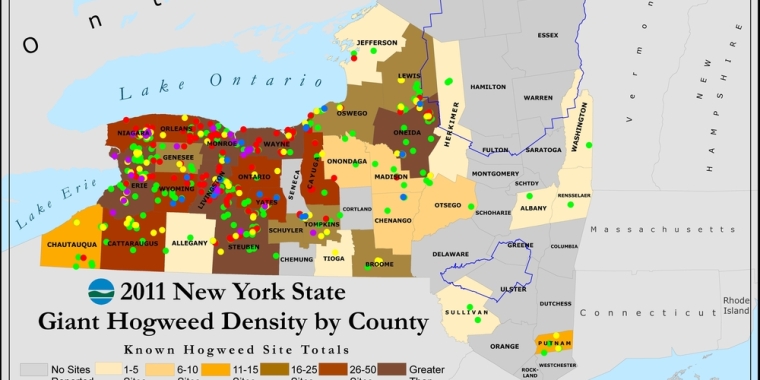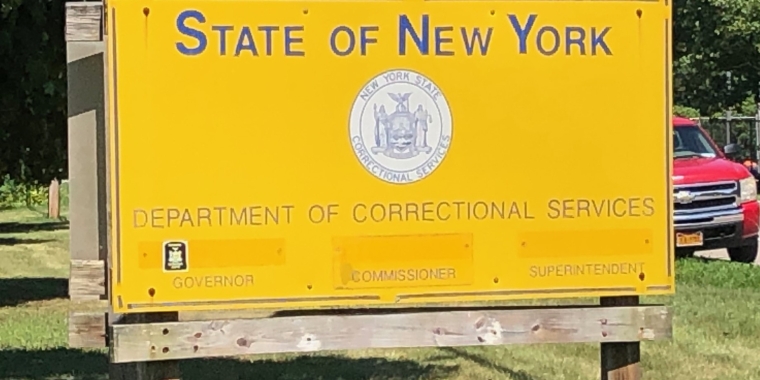
Giant Hogweed in New York State




A monster plant with flowers the size of umbrellas and sap that causes blisters and blindness is spreading across New York.
| From the NYS Dept. of Environmental Conservation |
Giant Hogweed
Do Not Touch This Plant!
Giant hogweed (Heracleum mantegazzianum) is a Federally listed noxious weed. Its sap, in combination with moisture and sunlight, can cause severe skin and eye irritation, painful blistering, permanent scarring and blindness
Contact between the skin and the sap of this plant occurs either through brushing against the bristles on the stem or breaking the stem or leaves.
What to do if you come in contact with giant hogweed:
This plant poses a serious health threat; see your physician if you think you have been burned by giant hogweed. If you think you have giant hogweed on your property, do NOT touch it.
How do you identify giant hogweed?
Giant hogweed is a biennial or perennial herb in the carrot family (Apiaceae) which can grow to 12 feet or more. Its hollow, ridged stems grow 2-4 inches in diameter and have dark reddish-purple blotches. Its large compound leaves can grow up to 5 feet wide. It's white flower heads can grow up to 2 1/2 feet in diameter. Please refer to the Giant Hogweed Identification page for further help.
Some other plants look very similar. If you need additional information or assistance in identifying your plant, you may call us at 845-256-3111. You will be asked to describe the plant height, stem color, leaf shape, flower color and shape, as well as give directions to the plant site. If you can take digital photos and email them to us, it would help us identify your plant.
Where is giant hogweed found?
map click here to view larger map
Giant hogweed is a native of the Caucasus Mountain region between the Black and Caspian Seas. It was introduced to Europe and the United Kingdom in the late nineteenth century and to the United States in the early twentieth century as an ornamental garden plant. It has become established in New York, Pennsylvania, Ohio, Maryland, Oregon, Washington, Michigan, Virginia, Vermont, New Hampshire and Maine. Seeds may also be distributed by birds and waterways, and can remain viable for over 10 years. The map to the right displays the current confirmed locations of giant hogweed sites in New York State.
- Giant Hogweed Identification - This page has photos of all parts of the giant hogweed plant as well as photos of common lookalike plants for identification purposes.
- Health Hazards & Safety Instructions for Giant Hogweed (with graphic photos) - This page describes the health hazards of giant hogweed and details how people should protect themselves against the harmful sap.
- How To Control Giant Hogweed - A variety of methods for controlling this non-native invasive plant.
- NYSDEC Giant Hogweed Control Program - Details the statewide giant hogweed control program protocol.
- Giant Hogweed Statewide Distribution Map - Statewide distribution and density of giant hogweed sites by county.
- Giant Hogweed Biology - This page describes the biology of giant hogweed plants to include their growth and devlopment stages, seed dispersal and viability, as well as the habitat and competition for giant hogweed plants
It's the giant hogweed, an invasive species, and the Department of Environmental Conservation is asking for help locating outbreaks so they can send crews to nip it in the bud.
The agency has a Giant Hogweed Hotline at 845-256-3111 for people to call and report sightings. Callers are asked to provide photos and site information, but avoid touching the plant.
This is DEC's fourth year of controlling giant hogweed. Six crews totaling 14 people will visit most of the 944 known giant hogweed sites. Sites with less than 400 plants will be controlled by hand cutting their roots; sites with more than 400 plants will be controlled with herbicide.



